Towards Circular Social Housing: An Exploration of Practices, Barriers, and Enablers
Abstract
1. Introduction
2. Research Background
2.1. Circular Economy in the Built Environment
2.2. Dutch Social Housing Organisations
2.3. Barriers and Enablers for a Circular Built Environment
3. Delphi Method
3.1. Preparation
3.1.1. Panel Formulation
3.1.2. Extensive List of Barriers and Enablers
3.2. Data Collection
3.2.1. Delphi Round I
3.2.2. Delphi Round II
3.3. Data Analysis
4. Results
4.1. Circular Economy Practices of the Dutch Social Housing Organisations
4.1.1. Current State of the CE Implementation
4.1.2. CE Strategies and Business Models
4.2. Barriers and Enablers for the Dutch Social Housing Organisations
4.2.1. Social and Cultural Barriers
4.2.2. Organisational Barriers
4.2.3. Financial Barriers
4.2.4. Sectoral Barriers
4.2.5. Technical and Technological Barriers
4.2.6. Regulatory Barriers
4.2.7. Social and Cultural Enablers
4.2.8. Organisational Enablers
4.2.9. Financial Enablers
4.2.10. Sectoral Enablers
4.2.11. Technical and Technological Enablers
4.2.12. Regulatory Enablers
4.3. High-Priority Issues and Potential Enablers
5. Discussion and Conclusions
Author Contributions
Funding
Institutional Review Board Statement
Informed Consent Statement
Data Availability Statement
Acknowledgments
Conflicts of Interest
References
- European Commission. Construction Sector—A Global Player; Internal Market, Industry, Entrepreneurship and SMEs Directorate General Energy Directorate General Joint Research Centre (JRC): Brussels, Belgium, 2016. [Google Scholar]
- Giljum, S.; Wieland, H.; Lutter, S.; Bruckner, M.; Wood, R.; Tukker, A.; Stadler, K. Identifying priority areas for European resource policies: A MRIO-based material footprint assessment. J. Econ. Struct. 2016, 5, 17. [Google Scholar] [CrossRef]
- Abergel, T.; Dulac, J.; Hamilton, I.; Jordan, M.; Pradeep, A. 2019 Global Status Report for Buildings and Construction—Towards a Zero-Emissions, Efficient and Resilient Buildings and Construction Sector. Available online: https://www.worldgbc.org/news-media/2019-global-status-report-buildings-and-construction (accessed on 10 November 2020).
- Gálvez-Martos, J.-L.; Styles, D.; Schoenberger, H.; Zeschmar-Lahl, B. Construction and demolition waste best management practice in Europe. Resour. Conserv. Recycl. 2018, 136, 166–178. [Google Scholar] [CrossRef]
- Bocken, N.M.P.; de Pauw, I.; Bakker, C.; van der Grinten, B. Product design and business model strategies for a circular economy. J. Ind. Prod. Eng. 2016, 33, 308–320. [Google Scholar] [CrossRef]
- Ellen MacArthur Foundation. Completing the Picture: How the Circular Economy Tackles Climate Change. Available online: https://www.ellenmacarthurfoundation.org/publications/completing-the-picture-climate-change (accessed on 20 December 2020).
- Eberhardt, L.C.M.; Birkved, M.; Birgisdottir, H. Building design and construction strategies for a circular economy. Archit. Eng. Des. Manag. 2020. [Google Scholar] [CrossRef]
- Merli, R.; Preziosi, M.; Acampora, A. How do scholars approach the circular economy? A systematic literature review. J. Clean. Prod. 2018, 178, 703–722. [Google Scholar] [CrossRef]
- Marino, A.; Pariso, P. Comparing European countries’ performances in the transition towards the Circular Economy. Sci. Total Environ. 2020, 729, 138142. [Google Scholar] [CrossRef]
- Rijksoverheid. A Circular Economy in the Netherlands by 2050; Het Ministerie van Infrastructuur en Milieu en het Ministerie van Economische Zaken: Den Haag, The Netherlands, 2016. [Google Scholar]
- Marie, I.; Quiasrawi, H. Closed-loop recycling of recycled concrete aggregates. J. Clean. Prod. 2012, 37, 243–248. [Google Scholar] [CrossRef]
- van Stijn, A.; Gruis, V.H. Circular Housing Retrofit Strategies and Solutions: Towards Modular, Mass-Customised and ‘Cyclable’ Retrofit Products. IOP Conf. Ser. Earth Environ. Sci. 2019, 290. [Google Scholar] [CrossRef]
- Prendeville, S.; Cherim, E.; Bocken, N. Circular Cities: Mapping Six Cities in Transition. Environ. Innov. Soc. Transit. 2018, 26, 171–194. [Google Scholar] [CrossRef]
- Cambier, C.; Galle, W.; De Temmerman, N. Research and Development Directions for Design Support Tools for Circular Building. Buildings 2020, 10, 142. [Google Scholar] [CrossRef]
- Leising, E.; Quist, J.; Bocken, N. Circular Economy in the building sector: Three cases and a collaboration tool. J. Clean. Prod. 2018, 176, 976–989. [Google Scholar] [CrossRef]
- van Stijn, A.; Gruis, V. Towards a circular built environment: An integral design tool for circular building components. Smart Sustain. Built Environ. 2020, 9, 635–653. [Google Scholar] [CrossRef]
- Sassanelli, C.; Rosa, P.; Rocca, R.; Terzi, S. Circular economy performance assessment methods: A systematic literature review. J. Clean. Prod. 2019, 229, 440–453. [Google Scholar] [CrossRef]
- Benachio, G.L.F.; Freitas, M.d.C.D.; Tavares, S.F. Circular economy in the construction industry: A systematic literature review. J. Clean. Prod. 2020, 260, 121046. [Google Scholar] [CrossRef]
- Munaro, M.R.; Tavares, S.F.; Bragança, L. Towards circular and more sustainable buildings: A systematic literature review on the circular economy in the built environment. J. Clean. Prod. 2020, 260, 121134. [Google Scholar] [CrossRef]
- Bilal, M.; Khan, K.I.A.; Thaheem, M.J.; Nasir, A.R. Current state and barriers to the circular economy in the building sector: Towards a mitigation framework. J. Clean. Prod. 2020, 276, 123250. [Google Scholar] [CrossRef]
- Eikelenboom, M.; Long, T.B.; de Jong, G. Circular strategies for social housing associations: Lessons from a Dutch case. J. Clean. Prod. 2021, 292, 126024. [Google Scholar] [CrossRef]
- Pittini, A.; Dijol, J.; Turnbull, D.; Whelan, M. The State of Housing in the EU 2019; Housing Europe, the European Federation of Public, Cooperative and Social Housing: Brussels, Belgium, 2019. [Google Scholar]
- AEDES. Aedes-Agenda 2020–2023: Wonen in Nederland, Dat Doen we Samen. Available online: https://www.aedes.nl/artikelen/aedes/vereniging/aedesagenda/aedesagenda.html (accessed on 10 December 2020).
- CBS. Voorraad Woningen; Eigendom, Type Verhuurder, Bewoning, Regio. Available online: https://opendata.cbs.nl/statline/#/CBS/nl/dataset/82900NED/table?ts=1604307084600 (accessed on 2 November 2020).
- Aedes. Dutch Social Housing in a Nutshell; Aedes: The Hague, The Netherlands, 2016. [Google Scholar]
- Ellen MacArthur Foundation. Towards the Circular Economy—Economic and Business Rationale for an Accelerated Transition. Available online: https://www.ellenmacarthurfoundation.org/publications/towards-a-circular-economy-business-rationale-for-an-accelerated-transition (accessed on 10 December 2020).
- Ghisellini, P.; Cialani, C.; Ulgiati, S. A review on circular economy: The expected transition to a balanced interplay of environmental and economic systems. J. Clean. Prod. 2016, 114, 11–32. [Google Scholar] [CrossRef]
- Blomsma, F.; Brennan, G. The Emergence of Circular Economy: A New Framing around Prolonging Resource Productivity. J. Ind. Ecol. 2017, 21, 603–614. [Google Scholar] [CrossRef]
- Kirchherr, J.; Reike, D.; Hekkert, M. Conceptualizing the circular economy: An analysis of 114 definitions. Resour. Conserv. Recycl. 2017, 127, 221–232. [Google Scholar] [CrossRef]
- Pomponi, F.; Moncaster, A. Circular economy for the built environment: A research framework. J. Clean. Prod. 2017, 143, 710–718. [Google Scholar] [CrossRef]
- Ellen MacArthur Foundation. Cities in the Circular Economy—An Initial Exploration. Available online: https://www.ellenmacarthurfoundation.org/publications/cities-in-the-circular-economy-an-initial-exploration (accessed on 12 December 2020).
- Circular Construction Economy Transition Team. De Circulaire Bouweconomie. Available online: https://ec.europa.eu/growth/tools-databases/regional-innovation-monitor/policy-document/noord-nederland/transition-agenda-2018-2021-%E2%80%98circulaire-bouweconomie (accessed on 21 December 2020).
- Ness, D.A.; Xing, K. Toward a Resource-Efficient Built Environment: A Literature Review and Conceptual Model. J. Ind. Ecol. 2017, 21, 572–592. [Google Scholar] [CrossRef]
- Ghisellini, P.; Ripa, M.; Ulgiati, S. Exploring environmental and economic costs and benefits of a circular economy approach to the construction and demolition sector. A literature review. J. Clean. Prod. 2018, 178, 618–643. [Google Scholar] [CrossRef]
- Potting, J.; Hekkert, M.P.; Worrell, E.; Hanemaaijer, A. Circular Economy: Measuring Innovation in the Product Chain; PBL Netherlands Environmental Assessment Agency: The Hague, The Netherlands, 2016.
- Ellen MacArthur Foundation. Delivering the Circular Economy: A Toolkit for Policymakers. Available online: https://www.ellenmacarthurfoundation.org/resources/apply/toolkit-for-policymakers (accessed on 1 October 2020).
- Zimmann, R.; O’Brien, H.; Hargrave, J.; Morrell, M. The Circular Economy in the Built Environment; ARUP: London, UK, 2016. [Google Scholar]
- Transitieteam Circulaire Bouweconomie. Circulaire Gebouwen Strategieën en Praktijkvoorbeelden; Rijksdienst voor Ondernemend Nederland: The Hague, The Netherlands, 2020. [Google Scholar]
- Boelhouwer, P.; Elsinga, M.; Gruis, V.; Priemus, H.; van der Schaar, J.; Thomsen, A. Wonen 6.0—Over de Toekomst van de Sociale huisvesting in Nederland; TU Delft—OTB—Onderzoek voor de gebouwde omgeving Faculteit Bouwkunde: Delft, The Netherlands, 2014. [Google Scholar]
- Boelhouwer, P.; Priemus, H. Demise of the Dutch social housing tradition: Impact of budget cuts and political changes. J. Hous. Built Environ. 2013, 29, 221–235. [Google Scholar] [CrossRef]
- Elsinga, M.; Wassenberg, F. Social Housing in the Netherlands. In Social Housing in Europe; Arrigoitia, M.F., Ed.; John Wiley & Sons: West Sussex, UK, 2014. [Google Scholar]
- Rijksoverheid. Commerciële en Maatschappelijke Activiteiten Woningcorporaties. Available online: https://www.rijksoverheid.nl/onderwerpen/woningcorporaties/activiteiten-woningcorporaties (accessed on 2 November 2020).
- Straub, A. Cost Savings from Performance-Based Maintenance Contracting. Int. J. Strateg. Prop. Manag. 2009, 13, 205–217. [Google Scholar] [CrossRef]
- Ministerie van Binnenlandse Zaken en Koninkrijksrelaties. Staat van de Volkshuisvesting—Jaarrapportage 2019. Available online: https://www.rijksoverheid.nl/documenten/rapporten/2019/05/28/rapport-staat-van-de-volkshuisvesting (accessed on 1 November 2020).
- Rijksoverheid. Aantal Corporaties Naar Grotteklasse. Available online: https://datawonen.nl/jive/jivereportcontents.ashx?report=cowb_framework_report_preview&chaptercode=2019_cowh7 (accessed on 2 November 2020).
- Aedes. Energie en Duurzaamheid- Wat Betekent Het Klimaatakkoord voor Corporaties. Available online: https://www.aedes.nl/artikelen/energie-en-duurzaamheid/achtergrond/wat-betekent-het-klimaatakkoord-voor-corporaties.html (accessed on 2 December 2020).
- Drenthe Woont Circulair. De Beweging Is Gestart! Available online: https://drenthewoontcirculair.nl/ (accessed on 6 November 2020).
- Corporatie Media. De Corporatie als Kringloopwinkel van Circulaire Woningen. Available online: https://www.corporatiegids.nl/nl/nieuws/de_corporatie_als_kringloopwinkel_van_circulaire_woningen-5944 (accessed on 6 November 2020).
- Durmisevic, E. Super Circular Estate project Journal No. 4; Urban Innovative Actions: Lille, France, 2020. [Google Scholar]
- Renda. Woonbedrijf Gaat Circulair. Available online: https://www.renda.nl/woonbedrijf_circulair (accessed on 7 November 2020).
- Eigen Haard. Duurzaamheid, Jaarverslag 2018. Available online: https://www.eigenhaard.nl/jaarverslag2018/in-woningen-van-goede-kwaliteit/duurzaamheid (accessed on 7 November 2020).
- Geng, Y.; Doberstein, B. Developing the circular economy in China: Challenges and opportunities for achieving ‘leapfrog development’. Int. J. Sustain. Dev. World Ecol. 2010, 15, 231–239. [Google Scholar] [CrossRef]
- Kirchherr, J.; Piscicelli, L.; Bour, R.; Kostense-Smit, E.; Muller, J.; Huibrechtse-Truijens, A.; Hekkert, M. Barriers to the Circular Economy: Evidence From the European Union (EU). Ecol. Econ. 2018, 150, 264–272. [Google Scholar] [CrossRef]
- de Jesus, A.; Mendonca, S. Lost in Transition? Drivers and Barriers in the Eco-innovation Road to the Circular Economy. Ecol. Econ. 2018, 145, 75–89. [Google Scholar] [CrossRef]
- Bressanelli, G.; Perona, M.; Saccani, N. Challenges in supply chain redesign for the Circular Economy: A literature review and a multiple case study. Int. J. Prod. Res. 2018, 57, 7395–7422. [Google Scholar] [CrossRef]
- Govindan, K.; Hasanagic, M. A systematic review on drivers, barriers, and practices towards circular economy: A supply chain perspective. Int. J. Prod. Res. 2018, 56, 278–311. [Google Scholar] [CrossRef]
- Ozkan-Ozen, Y.D.; Kazancoglu, Y.; Kumar Mangla, S. Synchronized Barriers for Circular Supply Chains in Industry 3.5/Industry 4.0 Transition for Sustainable Resource Management. Resour. Conserv. Recycl. 2020, 161. [Google Scholar] [CrossRef]
- Masi, D.; Kumar, V.; Garza-Reyes, J.A.; Godsell, J. Towards a more circular economy: Exploring the awareness, practices, and barriers from a focal firm perspective. Prod. Plan. Control 2018, 29, 539–550. [Google Scholar] [CrossRef]
- Rizos, V.; Behrens, A.; van der Gaast, W.; Hofman, E.; Ioannou, A.; Kafyeke, T.; Flamos, A.; Rinaldi, R.; Papadelis, S.; Hirschnitz-Garbers, M.; et al. Implementation of Circular Economy Business Models by Small and Medium-Sized Enterprises (SMEs): Barriers and Enablers. Sustainability 2016, 8, 1212. [Google Scholar] [CrossRef]
- Vermunt, D.A.; Negro, S.O.; Verweij, P.A.; Kuppens, D.V.; Hekkert, M.P. Exploring barriers to implementing different circular business models. J. Clean. Prod. 2019, 222, 891–902. [Google Scholar] [CrossRef]
- Adams, K.T.; Osmani, M.; Thorpe, T.; Thornback, J. Circular economy in construction: Current awareness, challenges and enablers. In Proceedings of the Institution of Civil Engineers—Waste and Resource Management; ICE Publishing: London, UK, 2017; Volume 170, pp. 15–24. [Google Scholar] [CrossRef]
- Jugend, D.; Fiorini, P.D.; Pinheiro, M.A.P.; da Silva, H.M.R.; Seles, B.M.R.P. Building Circular Products in an Emerging Economy: An Initial Exploration Regarding Practices, Drivers and Barriers Case studies of new product development from medium and large Brazilian companies. Johns. Matthey Technol. 2020, 64, 59–68. [Google Scholar] [CrossRef]
- Kanters, J. Circular Building Design: An Analysis of Barriers and Drivers for a Circular Building Sector. Buildings 2020, 10, 77. [Google Scholar] [CrossRef]
- Dalkey, N.C. Delphi; RAND Corporation: Santa Monica, CA, USA, 1967. [Google Scholar]
- Dalkey, N.; Helmer, O. An Experimental Application of the Delphi Method to the Use of Experts; RAND Corporation: Santa Monica, CA, USA, 1962. [Google Scholar]
- Okoli, C.; Pawlowski, S.D. The Delphi method as a research tool: An example, design considerations and applications. Inf. Manag. 2004, 42, 15–29. [Google Scholar] [CrossRef]
- Landeta, J. Current validity of the Delphi method in social sciences. Technol. Forecast. Soc. Chang. 2006, 73, 467–482. [Google Scholar] [CrossRef]
- von der Gracht, H.A. Consensus measurement in Delphi studies. Technol. Forecast. Soc. Chang. 2012, 79, 1525–1536. [Google Scholar] [CrossRef]
- Brady, S.R. Utilizing and Adapting the Delphi Method for Use in Qualitative Research. Int. J. Qual. Methods 2015, 14. [Google Scholar] [CrossRef]
- Remøy, H.T.; Koppels, P.; van Oel, C.; de Jonge, H. Characteristics of vacant offices, a Delphiapproach. In Proceedings of the ENHR International Conference Sustainable Urban Areas, Rotterdam, The Netherlands, 25–28 June 2007. [Google Scholar]
- Mullins, D. Exploring Change in the Housing Association Sector in England Using the Delphi Method. Hous. Stud. 2007, 21, 227–251. [Google Scholar] [CrossRef]
- Mullins, D.; Milligan, V.; Nieboer, N. State directed hybridity?—The relationship between non-profit housing organizations and the state in three national contexts. Hous. Stud. 2017, 33, 565–588. [Google Scholar] [CrossRef]
- Nieboer, N.; Gruis, V. Shifting back-changing organisational strategies in Dutch social housing. J. Hous. Built Environ. 2013, 29, 1–13. [Google Scholar] [CrossRef]
- Zeeman, H.; Wright, C.J.; Hellyer, T. Developing design guidelines for inclusive housing: A multi-stakeholder approach using a Delphi method. J. Hous. Built Environ. 2016, 31, 761–772. [Google Scholar] [CrossRef]
- Bui, T.D.; Tsai, F.M.; Tseng, M.-L.; Ali, M.H. Identifying sustainable solid waste management barriers in practice using the fuzzy Delphi method. Resour. Conserv. Recycl. 2020, 154, 104625. [Google Scholar] [CrossRef]
- Janik, A.; Ryszko, A. Circular economy in companies: An analysis of selected indicators from a managerial perspective. Multidiscip. Asp. Prod. Eng. 2019, 2, 523–535. [Google Scholar] [CrossRef]
- Padilla-Rivera, A.; Russo-Garrido, S.; Merveille, N. Addressing the Social Aspects of a Circular Economy: A Systematic Literature Review. Sustainability 2020, 12, 7912. [Google Scholar] [CrossRef]
- Prieto-Sandoval, V.; Ormazabal, M.; Jaca, C.; Viles, E. Key elements in assessing circular economy implementation in small and medium-sized enterprises. Bus. Strategy Environ. 2018, 27, 1525–1534. [Google Scholar] [CrossRef]
- Sharma, Y.K.; Mangla, S.K.; Patil, P.P.; Liu, S. When challenges impede the process. Manag. Decis. 2019, 57, 995–1017. [Google Scholar] [CrossRef]
- Giunipero, L.C.; Hooker, R.E.; Denslow, D. Purchasing and supply management sustainability: Drivers and barriers. J. Purch. Supply Manag. 2012, 18, 258–269. [Google Scholar] [CrossRef]
- Rowe, G.; Wright, G.; Bolger, F. Delphi: A reevaluation of research and theory. Technol. Forecast. Soc. Chang. 1991, 39, 235–251. [Google Scholar] [CrossRef]
- Rowe, G.; Wright, G. Expert Opinions IN Forecasting: The Role of the Delphi Technique. In Principles of Forecasting—A Handbook for Researchers and Practitioners; Armstrong, S., Ed.; Springer: Boston, MA, USA, 2001. [Google Scholar] [CrossRef]
- Sossa, J.W.Z.; Halal, W.; Zarta, R.H. Delphi method: Analysis of rounds, stakeholder and statistical indicators. Foresight 2019, 21, 525–544. [Google Scholar] [CrossRef]
- Hart, J.; Adams, K.; Giesekamc, J.; Tingleyd, D.D.; Pomponi, F. Barriers and drivers in a circular economy: The case of the built environment. In Proceedings of the Procedia CIRP, West Lafayette, IN, USA, 7–9 May 2019; pp. 619–624. [Google Scholar]
- Kok, L.; Wurpel, G.; Ten Wolde, A. Unleashing the Power of the Circular Economy; IMSA Amsterdam: Amsterdam, The Netherlands, 2013. [Google Scholar]
- Mahpour, A. Prioritizing barriers to adopt circular economy in construction and demolition waste management. Resour. Conserv. Recycl. 2018, 134, 216–227. [Google Scholar] [CrossRef]
- Shahbazi, S.; Wiktorsson, M.; Kurdve, M.; Jönsson, C.; Bjelkemyr, M. Material efficiency in manufacturing: Swedish evidence on potential, barriers and strategies. J. Clean. Prod. 2016, 127, 438–450. [Google Scholar] [CrossRef]
- Väisänen, J.-M.; Ranta, V.; Aarikka-Stenroos, L. Enabling Circular Economy with Software: A Multi-level Approach to Benefits, Requirements and Barriers. In Proceedings of the Software Business: 10th International Conference, ICSOB 2019, Jyväskylä, Finland, 18–20 November 2019. [Google Scholar]
- Wilts, H. The Digital Circular Economy: Can the Digital Transformation Pave the Way for Resource-Efficient Materials Cycles? Int. J. Environ. Sci. Nat. Resour. 2017, 7. [Google Scholar] [CrossRef]
- Ellen MacArthur Foundation. Intelligent Assets: Unlocking the Circular Economy Potential. Available online: https://www.ellenmacarthurfoundation.org/publications/intelligent-assets (accessed on 10 October 2020).
- Antikainen, M.; Uusitalo, T.; Kivikytö-Reponen, P. Digitalisation as an Enabler of Circular Economy. Procedia CIRP 2018, 73, 45–49. [Google Scholar] [CrossRef]
- Neligan, A. Digitalisation as Enabler Towards a Sustainable Circular Economy in Germany. Intereconomics 2018, 53, 101–106. [Google Scholar] [CrossRef]
- Manifest Belastinghervorming voor de Circulaire Bouweconomie. Available online: https://ex-tax.com/circulairebouw/ (accessed on 12 October 2020).
- Akinade, O.; Oyedele, L.; Oyedele, A.; Delgado, J.M.D.; Bilal, M.; Akanbi, L.; Ajayi, A.; Owolabi, H. Design for deconstruction using a circular economy approach: Barriers and strategies for improvement. Prod. Plan. Control 2020, 31, 829–840. [Google Scholar] [CrossRef]
- Densley Tingley, D.; Cooper, S.; Cullen, J. Understanding and overcoming the barriers to structural steel reuse, a UK perspective. J. Clean. Prod. 2017, 148, 642–652. [Google Scholar] [CrossRef]
- van den Brink, R.; Prins, M.; Straub, A.; Ploeger, H. Finding the right incentives; circular business models for the construction industry. In Proceedings of the International Research Conference 2017: Shaping Tomorrow’s Built Environment, Salford, UK, 11–12 September 2017. [Google Scholar]
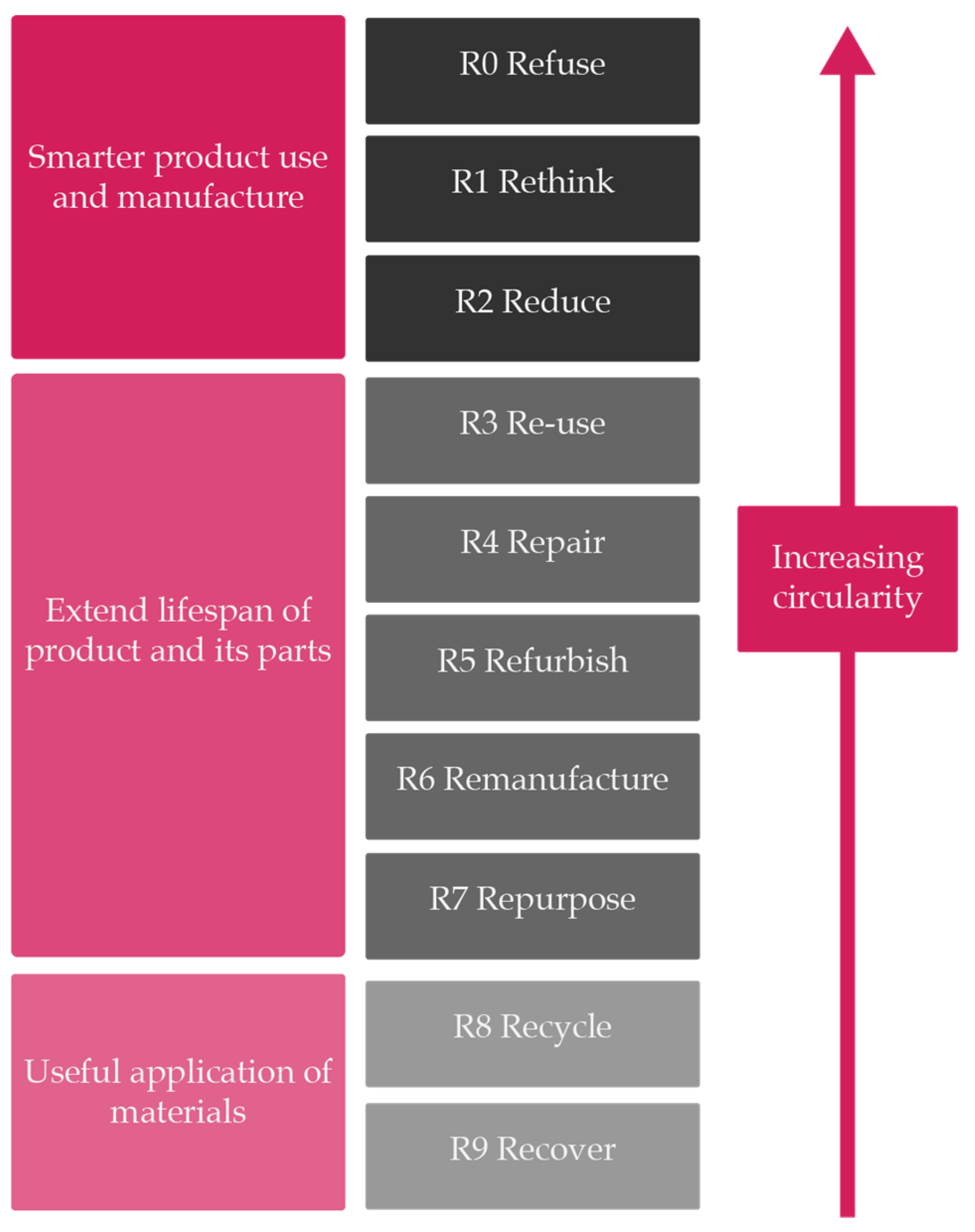
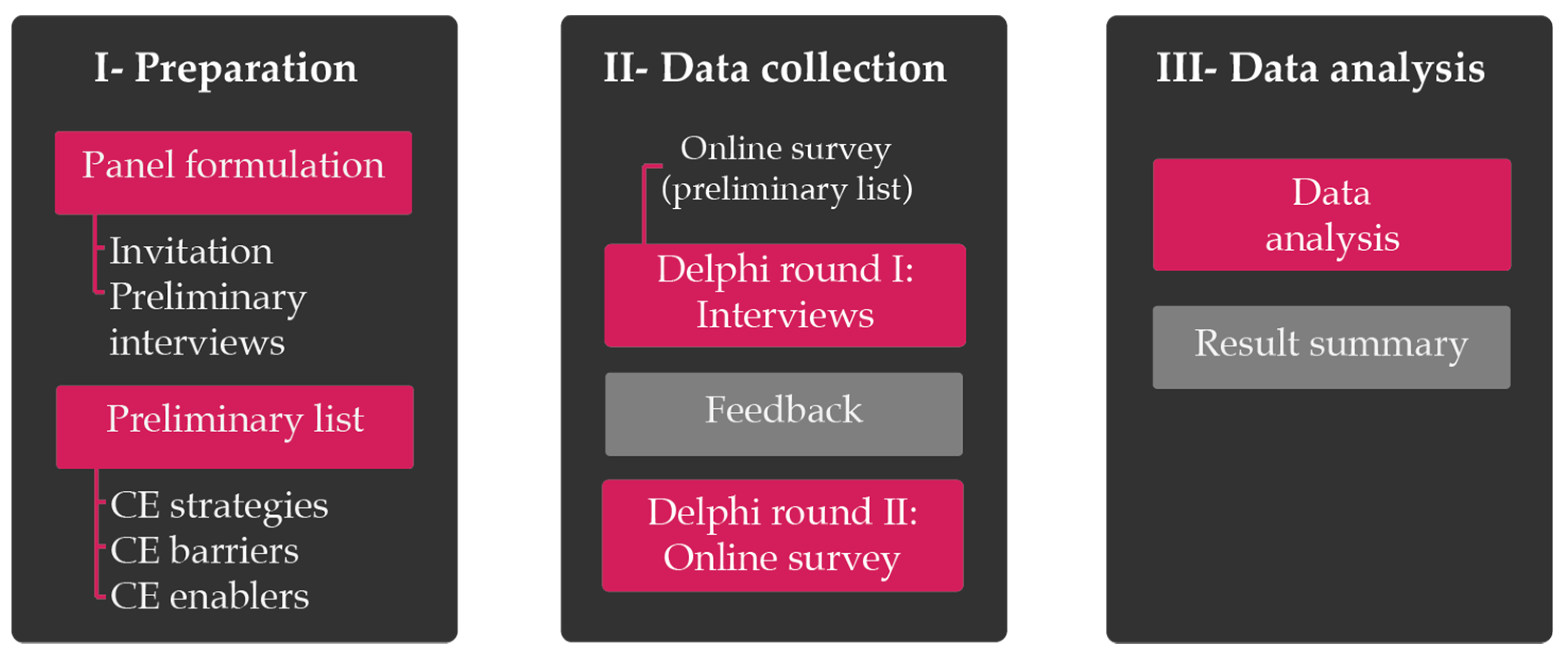
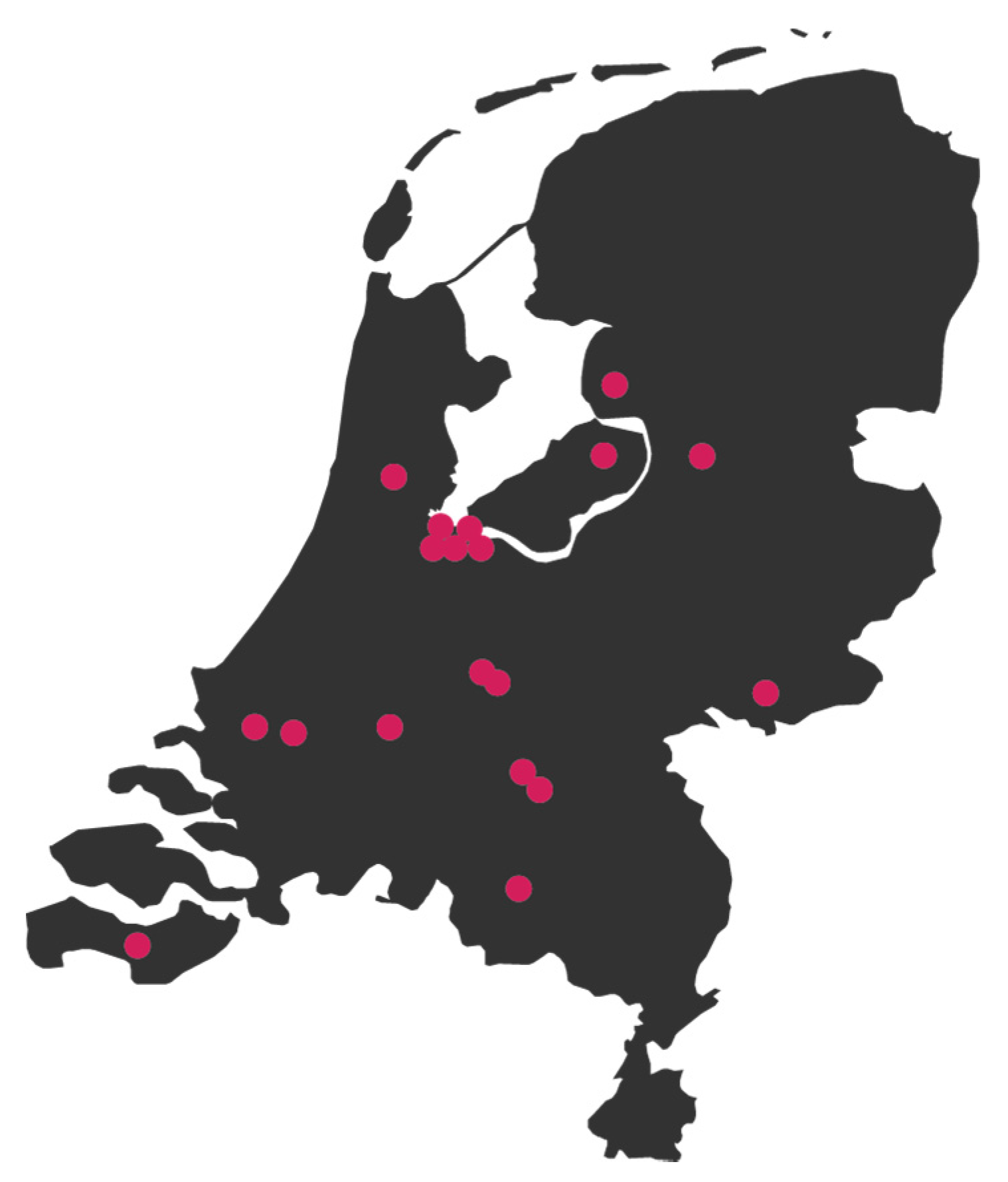
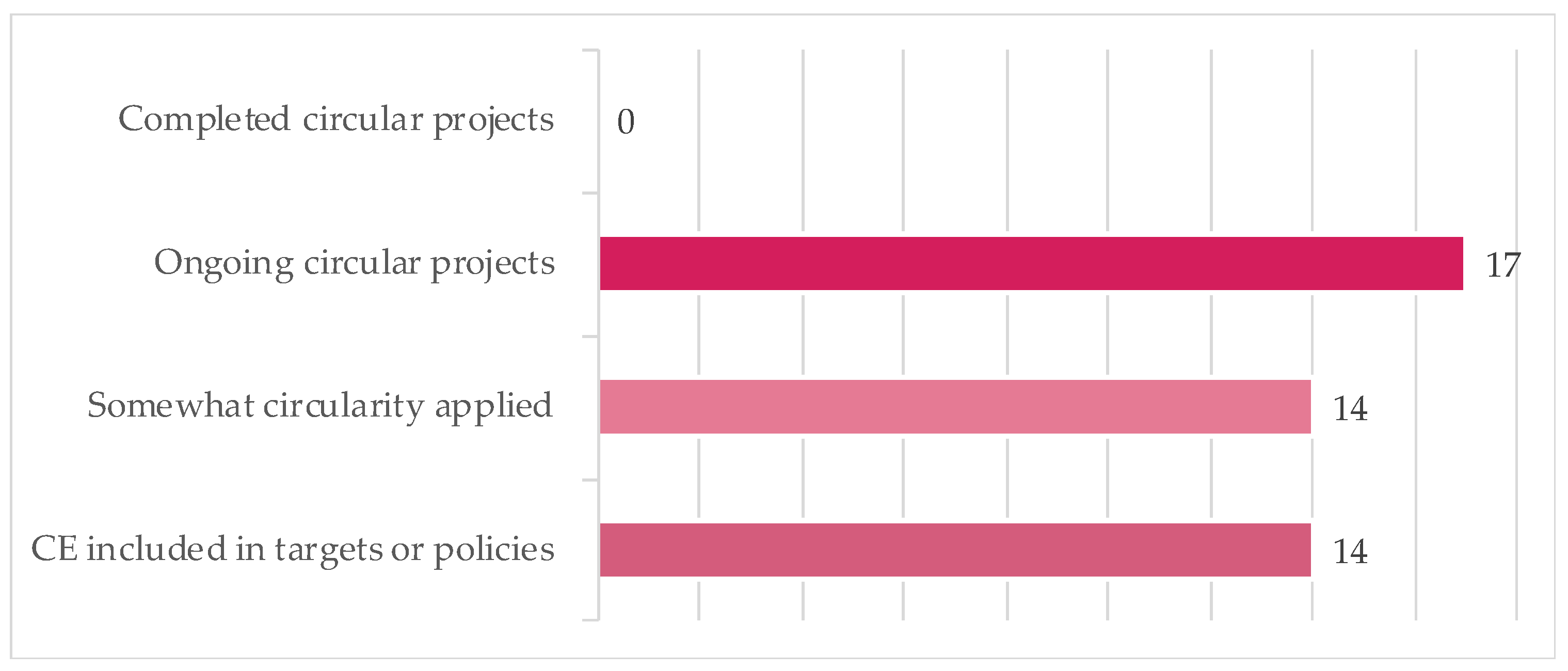
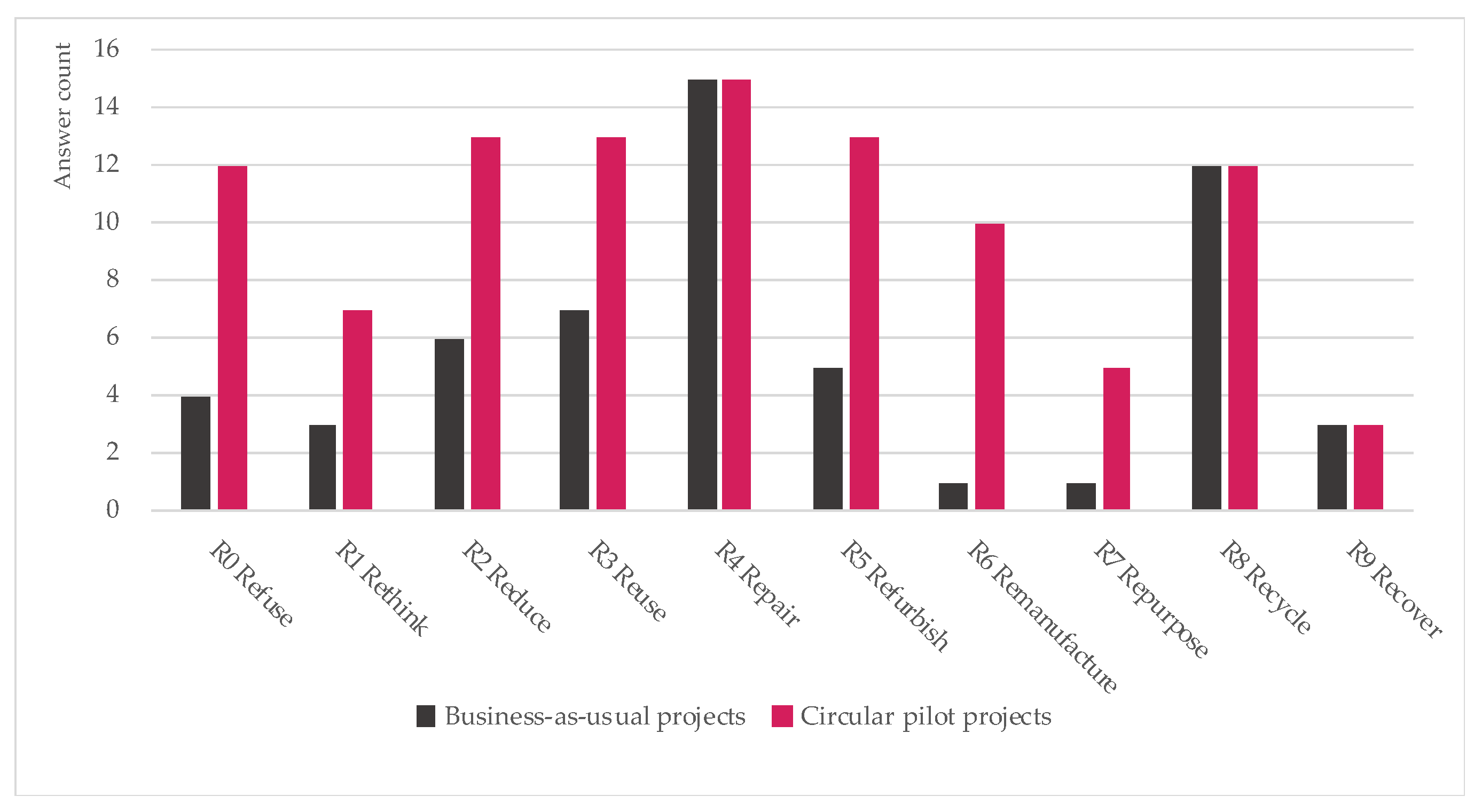
| SHO | Size (Dwellings Owned) |
|---|---|
| 1 | 35,800 |
| 2 | 43,000 |
| 3 | 50,000 |
| 4 | 69,400 |
| 5 | 55,800 |
| 6 | 15,000 |
| 7 | 25,000 |
| 8 | 33,000 |
| 9 | 4500 |
| 10 | 4000 |
| 11 | 56,000 |
| 12 | 4000 |
| 13 | 28,200 |
| 14 | 9000 |
| 15 | 11,000 |
| 16 | 15,200 |
| 17 | 4100 |
| 18 | 11,000 |
| 19 | 15,000 |
| Total dwellings | 489,000 |
| Profession | Professional Experience (Years) | Delphi Round 1 | Delphi Round 2 |
|---|---|---|---|
| Advisor | 34 | x | x |
| Advisor | 7 | x | |
| Advisor | 24 | x | x |
| Advisor | 22 | x | |
| Advisor | 22 | x | x |
| Director | 25 | x | x |
| Director | 25 | x | x |
| Director | 36 | x | x |
| Innovation manager | 10 | x | x |
| Program manager | 18 | x | x |
| Program manager | 20 | x | x |
| Project leader | 15 | x | x |
| Project leader | 16 | x | |
| Project leader | 18 | x | |
| Project manager | 30 | x | x |
| Project manager | 20 | x | x |
| Project manager | 14 | x | x |
| Real estate manager | 7 | x | x |
| Real estate manager | 25 | x | |
| Real estate manager | 20 | x | x |
| Real estate manager | 20 | x | |
| Total participants | 19 | 17 |
| Category | Barriers and eEnablers | Min | Max | Mean | Std dev | Mean Category |
|---|---|---|---|---|---|---|
| Barriers | ||||||
| Social and Cultural Barriers | Lack of awareness, knowledge and experience with the CE | 2 | 5 | 3.84 | 0.87 | 3.27 |
| Resistance from stakeholders | 2 | 5 | 3.42 | 0.94 | ||
| Tenant preference for new building products | 2 | 4 | 3.32 | 0.8 | ||
| Lack of willingness to collaborate across the supply chain | 1 | 4 | 3.26 | 0.85 | ||
| Lack of consumer (tenant) awareness and interest | 1 | 4 | 2.53 | 0.88 | ||
| Organisational Barriers | Giving higher priority to other issues, e.g., energy transition | 3 | 5 | 4.11 | 0.72 | 3.62 |
| Operating in a linear system | 2 | 5 | 3.68 | 0.8 | ||
| Limited top management commitment and support for circularity | 1 | 5 | 3.58 | 1.23 | ||
| Lack of time and human resources | 2 | 5 | 3.47 | 0.99 | ||
| Insufficient technical training and education on circularity | 1 | 5 | 3.26 | 1.02 | ||
| Financial Barriers | High purchasing costs of new circular materials | 3 | 5 | 4 | 0.46 | 3.8 |
| High purchasing costs of recycled materials | 2 | 5 | 3.95 | 0.69 | ||
| Unclear business case | 2 | 5 | 3.95 | 0.94 | ||
| High upfront investment costs | 3 | 5 | 3.89 | 0.72 | ||
| High costs for collecting, dismantling, urban mining | 2 | 5 | 3.84 | 0.59 | ||
| Limited funding for circular projects | 1 | 4 | 3.16 | 0.93 | ||
| Sectoral Barriers | Conservative and uncooperative nature of building industry | 2 | 5 | 3.79 | 0.95 | 3.42 |
| Lack of standardisation | 2 | 5 | 3.68 | 0.86 | ||
| Uncertainty in building end-of-life issues | 2 | 5 | 3.42 | 0.82 | ||
| Long product life-cycles | 1 | 5 | 3.37 | 1.13 | ||
| Poor partnership formation with supply chain | 2 | 5 | 3.26 | 1.07 | ||
| Complexity of buildings | 2 | 5 | 3 | 0.92 | ||
| Technical and Technological Barriers | Lack of an information exchange system | 2 | 5 | 3.68 | 0.86 | 3.5 |
| Lack of circular design guidelines | 2 | 5 | 3.53 | 0.82 | ||
| Lack of relevant tools for material reuse | 2 | 4 | 3.47 | 0.68 | ||
| High costs of implementing new technologies | 2 | 5 | 3.32 | 0.8 | ||
| Regulatory Barriers | Circularity is not effectively integrated in regulations | 2 | 5 | 3.68 | 0.8 | 3.51 |
| Limited circular procurement | 2 | 5 | 3.68 | 0.8 | ||
| Uncertainty regarding future legislation | 2 | 5 | 3.42 | 0.82 | ||
| Lack of global consensus on CE | 2 | 5 | 3.26 | 0.91 | ||
| Enablers | ||||||
| Social and Cultural Enablers | Leadership | 3 | 5 | 4.21 | 0.61 | 3.84 |
| Collaborating with other social housing organizations | 3 | 5 | 4.05 | 0.6 | ||
| Circular economy training, education and workshops | 2 | 5 | 3.84 | 0.67 | ||
| Social awareness and shifting tenant preferences | 3 | 5 | 3.79 | 0.61 | ||
| Awareness raising events | 3 | 4 | 3.32 | 0.46 | ||
| Organisational Enablers | Commitment and support from the top management | 3 | 5 | 4.58 | 0.59 | 4.09 |
| High priority on circularity within the organisation | 2 | 5 | 3.95 | 0.89 | ||
| Collaboration of internal teams | 2 | 5 | 3.74 | 0.64 | ||
| Financial Enablers | Clear business case for CE | 3 | 5 | 4.05 | 0.83 | 3.91 |
| Lower costs for circular materials | 3 | 5 | 4.05 | 0.6 | ||
| Financial incentives to use secondary materials | 2 | 5 | 3.84 | 0.93 | ||
| Lower costs for collecting, dismantling, urban mining | 2 | 5 | 3.84 | 0.87 | ||
| Sufficient funding for circular projects | 2 | 5 | 3.79 | 0.83 | ||
| Sectoral Enablers | R&D and innovation | 3 | 5 | 4.05 | 0.69 | 3.99 |
| Best practice case studies | 3 | 5 | 4 | 0.56 | ||
| Better collaboration with sector parties | 3 | 5 | 3.95 | 0.6 | ||
| Development of standards | 2 | 5 | 3.95 | 0.83 | ||
| Technical and Technological Enablers | Development of enabling technologies | 3 | 5 | 3.95 | 0.6 | 3.87 |
| Development of tools and guidelines | 2 | 5 | 3.84 | 0.74 | ||
| Development of digital marketplaces for secondary material | 2 | 5 | 3.84 | 0.93 | ||
| Development of circular procurement systems | 2 | 5 | 3.84 | 0.81 | ||
| Regulatory Enablers | Incentives for CE | 2 | 5 | 4.11 | 0.72 | 3.96 |
| Circular economy legislation | 3 | 5 | 4.05 | 0.69 | ||
| Policy support | 3 | 5 | 3.95 | 0.51 | ||
| Waste management directives | 2 | 5 | 3.95 | 0.83 | ||
| Global agreement on circular economy | 2 | 5 | 3.74 | 0.85 |
| Rank | High-Priority Issues | Min | Max | Mean | Std Dev | Median | Inter. Range |
|---|---|---|---|---|---|---|---|
| 1 | Higher priority in other issues, e.g., energy transition | 1 | 9 | 3.60 | 2.50 | 3 | 4 |
| 2 | Operating in a linear system | 1 | 11 | 3.80 | 3.21 | 3 | 5 |
| 3 | Lack of awareness, knowledge and experience with the CE | 1 | 8 | 4.00 | 2.07 | 4 | 4 |
| 4 | High purchasing costs of circular materials (new and recycled) | 1 | 13 | 4.93 | 3.66 | 4 | 5 |
| 5 | Unclear business case | 2 | 11 | 5.53 | 2.55 | 5 | 4 |
| 6 | Conservative and uncooperative nature of building industry | 1 | 13 | 5.87 | 3.56 | 7 | 6 |
| 7 | Lack of standardization in circularity | 2 | 9 | 6.60 | 2.18 | 8 | 3 |
| 8 | Lack of an information exchange system | 3 | 13 | 8.67 | 2.44 | 9 | 3 |
| 9 | Resistance from stakeholders | 3 | 13 | 8.73 | 3.86 | 12 | 5 |
| 10 | Lack of circular design and implementation guidelines | 6 | 13 | 9.20 | 2.10 | 10 | 4 |
| 11 | The building code, rules and regulations hinder reusing building materials | 4 | 13 | 9.33 | 2.98 | 10 | 5 |
| 12 | Circularity is not effectively integrated in innovation policies | 1 | 13 | 10.27 | 3.28 | 12 | 4 |
| 13 | Limited circular procurement | 8 | 13 | 10.47 | 1.26 | 10 | 1 |
| Rank | High-Priority Issues | Potential Enablers |
|---|---|---|
| 1 | Higher priority in other issues | Giving higher priority on circularity within the organisation |
| (Organisational) | CE Legislation | |
| Leadership in circularity | ||
| Commitment and support from the top management | ||
| Combining energy efficiency and CE targets * | ||
| 2 | Operating in a linear system | Best practice case studies |
| (Organisational) | Collaborating with other housing organizations | |
| CE Legislation | ||
| Leadership in circularity | ||
| R&D and innovation | ||
| Better collaboration with sector parties | ||
| Introduction of change management practices * | ||
| 3 | Lack of awareness, knowledge and experience with the CE | Best practice case studies |
| (Social and cultural) | Development of circular design and implementation guidelines | |
| Giving higher priority on circularity within the organisation | ||
| CE training, workshops, education | ||
| Making experiments with supply chain actors * | ||
| Introduction of clear measurement methods for circularity * | ||
| Lobbying for CE * | ||
| 4 | High purchasing costs of circular materials (new and recycled) | Clear business case |
| (Financial) | Development of enabling technologies to recover materials | |
| R&D and innovation | ||
| CE Legislation | ||
| Development of circular procurement systems | ||
| Lower costs for circular materials | ||
| CE training, workshops, education | ||
| CO2 tax on materials * | ||
| Considering life-cycle costs * | ||
| Making experiments with circular materials and products * | ||
| 5 | Unclear business case | Clear business case |
| (Financial) | Best practice case studies | |
| R&D and innovation | ||
| Commitment and support from the top management | ||
| Incentives for CE | ||
| Development of circular procurement systems | ||
| Development of standards | ||
| CO2 tax on materials * |
Publisher’s Note: MDPI stays neutral with regard to jurisdictional claims in published maps and institutional affiliations. |
© 2021 by the authors. Licensee MDPI, Basel, Switzerland. This article is an open access article distributed under the terms and conditions of the Creative Commons Attribution (CC BY) license (http://creativecommons.org/licenses/by/4.0/).
Share and Cite
Çetin, S.; Gruis, V.; Straub, A. Towards Circular Social Housing: An Exploration of Practices, Barriers, and Enablers. Sustainability 2021, 13, 2100. https://doi.org/10.3390/su13042100
Çetin S, Gruis V, Straub A. Towards Circular Social Housing: An Exploration of Practices, Barriers, and Enablers. Sustainability. 2021; 13(4):2100. https://doi.org/10.3390/su13042100
Chicago/Turabian StyleÇetin, Sultan, Vincent Gruis, and Ad Straub. 2021. "Towards Circular Social Housing: An Exploration of Practices, Barriers, and Enablers" Sustainability 13, no. 4: 2100. https://doi.org/10.3390/su13042100
APA StyleÇetin, S., Gruis, V., & Straub, A. (2021). Towards Circular Social Housing: An Exploration of Practices, Barriers, and Enablers. Sustainability, 13(4), 2100. https://doi.org/10.3390/su13042100







